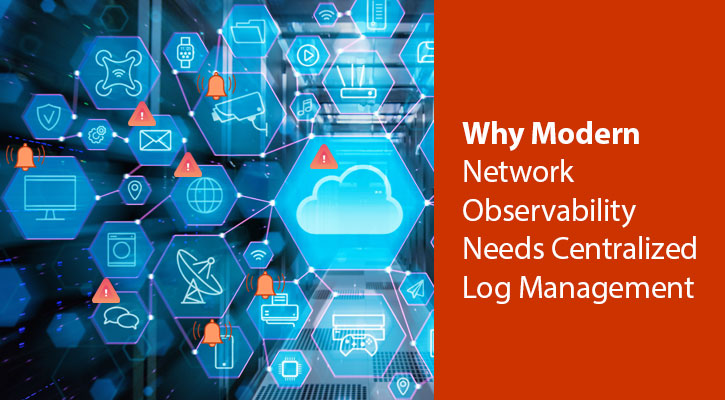Why Modern Network Observability Needs Centralized Log Data Management

As networks become increasingly complex with cloud services, remote work, and hybrid infrastructure, IT managers face an unprecedented challenge: maintaining network observability across distributed environments while managing costs and complexity.
🌩️ Log Data Management: Business Challenges l Technical Value
The Modern Network Visibility Challenge
Organizations that implement centralized network event orchestration platforms typically see significant operational improvements:
- Fragmented visibility across multiple network monitoring tools and dashboards
- Slow incident responsedue to manual correlation across data silos
- Fragmented visibility across multiple network monitoring tools and dashboards
- Resource inefficiency from redundant monitoring systems and overlapping functionality
- Scaling challenges as network complexity outpaces traditional syslog tool approaches
The Business Case for Centralized Log Data Management Orchestration
The solution isn’t collecting less data—it’s processing it intelligently before expensive SIEM ingestion. Advanced SIEM pre-processor solutions can eliminate up to 97% of redundant log entries through real-time deduplication, dramatically reducing both licensing costs and storage overhead while maintaining full investigative capability.
- Faster Problem Resolution Unified visibility enables IT teams to correlate events across the entire infrastructure, reducing mean time to restore by 50-70%. Instead of checking multiple tools and screens, administrators can identify root causes from a single console with comprehensive log analysis capabilities.
- Reduced Tool Sprawl Consolidating alert management reduces both licensing costs and operational complexity. Organizations often eliminate 3-5 separate monitoring tools when implementing comprehensive centralized platforms, creating opportunities to reduce SIEM costs through consolidation.
- Improved Resource Utilization High-performance hardware architectures—featuring multi-core processors, substantial RAM, and NVMe storage—ensure that network intelligence platforms can handle massive data volumes without performance degradation, even during peak network activity.
The Power of Event Enrichment and Processing
Enterprise-grade platforms built on optimized hardware deliver consistent performance that software-only solutions often struggle to match. Key architectural advantages include:
- Processing Power Multi-core processors (24+ cores) enable real-time analysis of millions of events per second, supporting large-scale enterprise network monitoring without bottlenecks.
- Memory Architecture Substantial ECC RAM (256GB+) supports in-memory indexing and search capabilities, delivering sub-second query responses even across large datasets with advanced event enrichment.
- Storage Performance All-NVMe storage arrays provide the high IOPS required for continuous log ingestion while supporting fast searches across historical data, functioning as a high-performance syslog server foundation.
Integration and Automation Benefits
Modern network intelligence platforms excel at aggregating data from diverse sources—traditional network devices, cloud services, containers, and applications—providing unified network observability that grows with organizational needs.
This integration capability is particularly valuable for IT managers dealing with hybrid environments where traditional monitoring approaches create blind spots or require multiple specialized tools. Advanced IT automation capabilities help eliminate duplicate alerts and streamline network incident response workflows.
ROI Through Operational Efficiency
The business value extends beyond technical capabilities. Organizations implementing centralized network intelligence typically achieve:
- 30-50% reduction in time spent on routine troubleshooting through false positive reduction.
- Improved compliance through automated reporting and audit trails.
- Better capacity planning through comprehensive performance analytics.
- Enhanced security posture via integrated threat detection capabilities that prevent network outages.
Conclusion
For IT managers navigating increasingly complex network environments, centralized intelligence platforms represent a strategic investment in operational efficiency. The combination of powerful hardware, intelligent software, and unified visibility transforms network operations from reactive firefighting to proactive management—delivering measurable business value while positioning organizations for future growth.
Find a Trusted System Integrator Partner
As your organization adopts a modern network observability strategy, choosing the right hardware and integration partner is critical. While any system integrator can procure commodity rack servers, achieving true performance requires specialized expertise. The LogZilla SIEM appliance, built in partnership with Pogo Linux, is engineered to handle the demands of today’s complex networks. Pogo Linux customizes each appliance to optimize compute throughput, storage targets, and network performance, ensuring your LogZilla deployment runs at peak efficiency.
To take the first step toward transforming your IT operations, contact us today. Explore how a purpose-built SIEM appliance can power your network observability strategy and drive your business forward in 2025 and beyond.
